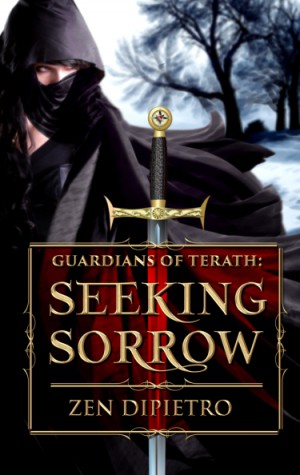Let me begin by saying that writing a novel is a terrific achievement. I know, having written two. My hat is off to anyone who can complete a novel.
That said, here is my honest opinion of Seeking Sorrow, subtitled “Guardians of Terath,” a character-driven sword-and-science fiction fantasy.
Characters: In large part, Seeking Sorrow (love that title), is the story of Kassimeigh, a strong, authoritarian woman, who through the course of the story, discovers unsuspected depths of power and emotion within herself.
Kassimeigh — not sure how to pronounce it — “Kass-eh-May,” maybe? — is the gem in a ring-setting of four other main characters, written as an ensemble. Together they create a fine chemistry as they grow to know one another through action and time.
Kassimeigh’s associates include handsome young men Arc, a gallant archer; and Will, a swashbuckling fighting-man or “blade.” Also part of the ensemble — Luc (pronounced “Luke,” I believe), is a middle-aged “manahi,” — a sort of psychic engineer who can manipulate the energy fields known as mana which which permeate Zen’s world of Terath. Rounding out the group is Izzy Gin, a snarky, but good-hearted young woman who is a “reader” — a powerful empath.
Zen does a lovingly detailed job bringing her characters to life in all three character dimensions — dialogue, action and physical description, along with narration of their thoughts and feelings.
Here’s Izzy Gin as seen by Will when they first meet at a museum.
Fine, light blue hair grazed the woman’s jawline in a blunt bob. The unusual shade was surprisingly well-suited to her whiskey-colored eyes and lightly tanned complexion. She was a good bit shorter than he was, and in her mid-twenties, he estimated. She wore a long, casual dress that did not shy away from the curves underneath. His appraisal skidded to a stop when he noticed her wide mouth curving into an even wider smile. Like his own, her gaze remained on the artwork, but she nonetheless had realized that he was studying her. And she apparently found it amusing.
I found Kassimeigh and her four cohorts reminiscent, though not derivative, of D’artagnan and the three Musketeers; and Frodo, with Sam, Merry and Pippin. In a stretch, I could see Luc as a Gandalf-type, though on her website, Zen suggests Luc’s character was influenced by Jean Luc Picard. However, I found nothing less than originality in all of them.
Lesser and supernumerary characters are also finely crafted. These are fully realized beings, and because Zen obviously loves them, I found I did too.
Plot: After the town of Sorrow is suddenly and absolutely obliterated, Magistrate Trewe recruits a team of five specialists to learn what happened and who is responsible. The team’s investigation leads them to the remotest corners of both Terath and their own souls.
Setting: Seeking Sorrow takes place in Terath, a somewhat earthlike world. Terath appears technologically advanced in some ways. There’s a global monorail and electronic communication, but weapons seem limited to sword, and bow and arrow technology. The narrative takes readers through three main areas of Terath — the temperate, garden-like “Mid Lats,” and the northerly, inhospitable lands of Sub-Apex and Apex.
While Zen offers some decent landscape description, her settings don’t get the love she gives her characters. Here’s a glimpse of Apex.
The terrain remained uninspiring even though it shifted from broad, flat expanses to peaks that rolled down into plateaus. The variability of the land in Apex perplexed him. It was always barren, and rocky, and ugly, but sometimes it was mostly flat and sometimes large rock formations loomed up, slowing their progress, and requiring them to navigate around to maintain their heading. At least Sub-Apex had been uniformly flat.
Her interior settings, often reflections of her characters, get more detailed descriptions.
What I thought could’ve been done better: While characters are close to being perfectly rendered, I thought Seeking Sorrow had some minor omissions of clarity and detail. For instance, in the group’s investigation into Apex, Luc senses a “mana signature,” which might be tied to the use of mana in the destruction of Sorrow. Where is this signature coming from? How do they know if it’s good or bad? These questions are not answered, and yet the team feels the appropriate response is to return with a fighting force of 300. Zen’s narrative, however, offers no clue as to why this is an appropriate response, or what the 300 might be up against — until, a little later in the narrative, they do come up against it.
Also, in Terath, Zen has created an intriguing world, but is short on the details of what that world is like. She drops interesting clues here and there, but in the main, I would’ve liked to know more. What for instance, is it like to ride on that monorail? The motorized carts our team uses for transport into the wilderness — I envisioned a sort of motorized oxcart, but would’ve liked some help from the narrative. There are many interesting, revealing conversations over meals, but few hints as to what the food and drink are like.
“Izzy broke off to help herself to another bite of vegetable.” Okay, what’s that vegetable like? Sweet and spongy? Maybe Izzy likes the vegetable’s crunchy, slightly acidic taste? These kinds of minor details, folded into action and dialogue, would help to make Terath as real and alive as the characters it hosts.
What I thought was good: Zen’s writing is crisp, active and verbal. Her prose is rich with metaphor, simile, personification and other gem-like figures of speech. “He heard an impact, a guttural sound, and a gasp just as the ground broke his fall with a jarring lack of sympathy.”
“…jarring lack of sympathy.” Love it.
While there is a lot of dialogue, Zen handles it well, and it moves the story along briskly. I would’ve liked a little more in the landscape description arena, but Zen’s emotional landscapes are superb. Here’s Kassimeigh, wounded after a skirmish; and Arc, providing unwanted medical attention:
She drew in a ragged breath. He wondered whether she would first tell him her name or thank him for helping.
“You’re a manahi!” she accused. “You healed me!” Her outrage put a flush on her pale cheeks.
“You’re welcome.” He ran the hand not smeared with her blood through his hair. “But you know I’m not a manahi. I have no idea what just happened. I really, really wish I did.”
She pressed her face into her palm. His mind filled with questions about who she was. He touched her cheek without meaning to. When his skin brushed hers, he again felt the tingle he now knew to associate with her.
“I keep feeling that when you’re near,” he told her softly. “What is it?” He knew he shouldn’t have touched her. She was still a justice, no matter what had just happened. He only hoped she’d choose talking to him over kicking his ass.
She dropped her hand. She wanted to look away from him but failed. Her failure to control her reaction pissed her off. She knew he was seeing her now. As a person, not just as a shiv. And what he’d just done . . . The air surrounding her seemed too thick to pull into her lungs.
When Zen does address setting description, it’s good. Here’s the “Apex glow,” the Terath version of Northern Lights.
As they stepped away from the high walls of their shelter, the sky opened to them in a massive expanse of swirling, gleaming color. They walked into the cold air, bathed in a dream world of iridescence.
“Wow,” Izzy exhaled. “I’ve heard of Apex glow but never realized it was so . . .” She failed to find the right word and fell silent. She stretched a hand up toward the sky and her skin became pinkish. She laughed and did a slow twirl in the light.
Arc lifted his hand and it glowed indigo. His laugh of simple delight joined Izzy’s. Not to be outdone, Will lifted both his hands, and they shone an icy blue. “My hands match your hair!” He grinned at Izzy.
Kassimeigh raised her own fingertips toward the sky, and saw pink and purple light dance across her digits. She waggled her fingers slightly, and color wafted around them in lazy whorls. She smiled at the colors dancing around her hands, in spite of the fact that her exposed skin grew quite cold. She ignored the chill. The colorful display trumped the discomfort from elements.
While the ratio of dialogue scenes to battle scenes skews heavily to dialogue, Zen’s two main battle scenes are action-packed and vivid. The second even qualifies as apocalyptic, imho.
Overall: Though Seeking Sorrow might have had a bit more detail about this interesting world of Terath, and a touch more clarity here and there, it serves up plenty of wonders and horrors. The writing is crisp, vivid and action-packed, filled with delightful turns of phrase, and is more than enough to overshadow any perceived flaws.
Zen’s characters are rich, fully developed and sympathetic. Their journey of discovery into themselves, each other, and the fate of Sorrow, are a fine contribution to the literature of fantasy and the quest.
Good job Zen!
Coming up
Verliege by Micheal Rivers
Time of Death by Ellis Vidler
The Permeable Web of Time by Martha Fawcett
Ascent of Blood by Elizabeth Marx
And for sexy superheroine paranormal sci fi romantic adventure thrillers, check out my own novel American Goddesses on Amazon or Smashwords, and the newly published sequel Rogue Goddesses ~ thanks for visiting Honest Indie!




A detailed and thorough review as always Gary – I do like the little snippets you include to give a taster of the authors writing style – “…jarring lack of sympathy” I loved that as well 🙂 Excellent!!